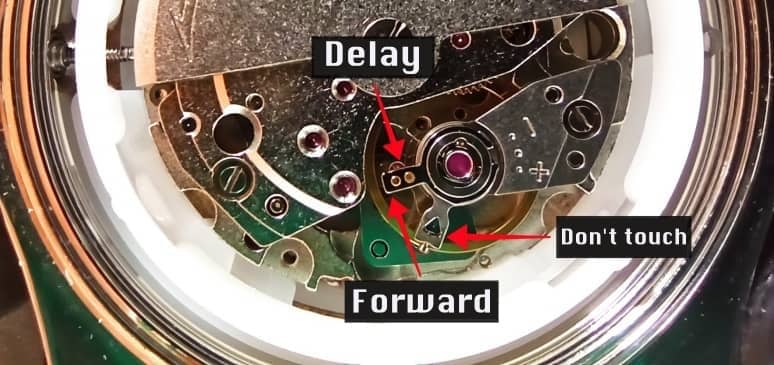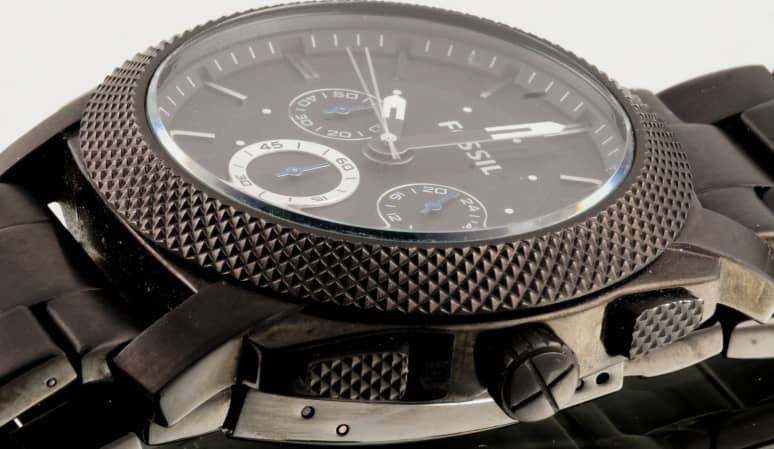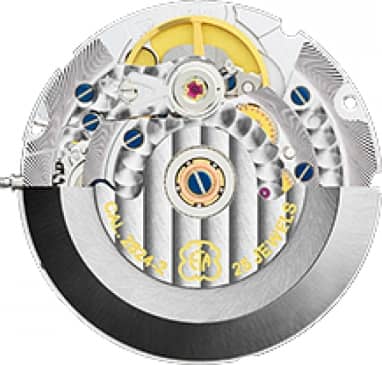Adjusting an automatic watch that gains or loses time is simpler than it seems; all you need is a bit of finesse and some patience.
Most mechanical watches can be adjusted by gently moving the pallet fork, a small lever accessible on the surface of the mechanism.
In some cases, the movement might even have the + and – signs engraved to make it easier to determine which direction to move the pallet fork.
For easy understanding, it’s best to watch a live demonstration of adjusting an automatic watch, and there’s nothing better for that than a video like the one shown below.
Índice de contenidos
Adjusting an Automatic Watch in Video
As you can see, the most complicated part is essentially opening the watch back if you don’t have the appropriate tool or if it has been a long time since you last opened it.
In summary, the steps to adjust an automatic watch are as follows:
1. Measure Accuracy
Before adjusting your automatic watch, the first step is to determine if it needs adjustment. You can use a simple app that measures the movement’s accuracy.
I use Watch Accuracy Meter on my Android phone because it’s free and easy to use, but there are several available.
Simply bring your phone’s microphone close to the watch, and the app will measure accuracy based on the ticking of the movement.
In my case, I use hands-free headphones as their small microphone is ideal for placing it close to the watch mechanism.
2. Open the Watch
The next step is to open the watch to access the mechanism, which depending on the type of case back, might require specific tools.
If it has a screw-down case back, you’ll need a jaxa wrench to apply pressure to the corresponding notches and unscrew the cover.
If it’s a snap-on case back, you can use a small knife to carefully pry it open. There are also specific tools for this purpose.
Currently, there are numerous affordable watchmaker tool kits that include all these tools. Here’s a good example:
- 【Juego de herramientas de reparación de relojes】 - El juego de herramientas de reparación de relojes JOREST contiene herramientas comunes...
- 【Ajustar la correa】- Soporte de banda de reloj de plástico,Punzones, Martillo de dos cabezas con Herramienta de barra de resorte con escala Se...
- 【Adecuado para diferentes cubiertas de reloj】 - El abridor de caja de reloj se usa para cajas de reloj con ranuras;La palanca de apertura de la...
- 【Destornillador de reloj cinco en uno】 - Cinco tipos de puntas de destornillador son adecuados para muchas situaciones: tornillos de fijación de...
- 【El propósito del soporte de la caja del reloj】 - El soporte de la caja del reloj se puede usar con otras herramientas en el kit para ayudar a...
The issue with snap-on case watches is that often it’s practically impossible to reseat the cover to close them.
If you encounter this problem, there’s a specific tool that solves it – it’s called a watch press, and it’s not particularly expensive either. Here’s an example:
- 【Tipos de reloj aplicables】1. Este juego sólo es adecuado para esferas redondas con diámetros entre 22 mm y 42 mm; 2. Sólo es adecuado para...
- 【Mayor estabilidad】El impacto de una herramienta de prensado para relojes biselada normal puede hacer que el reloj o la tapa se desplacen...
- 【Mayor presión hacia abajo】En comparación con las herramientas angulares para prensar relojes ordinarias, nuestras herramientas para prensar...
- 【Película protectora】Mediante el uso de una película protectora transparente, podemos fijar mejor la caja trasera y el reloj juntos para evitar...
- 【Consejos cálidos】1. Al girar y presionar con fuerza, la palanca debe ajustarse a la posición central para evitar roturas. 2. Para facilitar el...
3. Gently Move the Pallet Fork
Once the watch is open, you can easily identify the pallet fork located just above the balance wheel (the moving part). It’s clearer with an image:
The pallet fork or moving lever is usually the smaller lever positioned at the top. Gently push it with a toothpick or a small screwdriver to regulate the movement’s rate.
It’s important not to touch the fixed lever (the larger lever seen below), as this could damage the mechanism.
Some movements even have the + and – signs engraved to make it easier to determine which direction to move the pallet fork to advance or retard the watch.
If the movement has no markings and you’re unsure about the direction to push the moving lever, remember that moving it closer to the fixed point will cause the watch to slow down, while moving it away will make it run faster – that’s how simple it is.
The challenging part is applying just the right pressure to the pallet fork, as a slight movement of just half a millimeter can result in a gain or loss of more than 20 seconds.
You’ll likely need several attempts to regulate the mechanism to the desired speed, but with a bit of patience, you can achieve good results.
4. Re-Measure Accuracy
After adjusting the pallet fork, measure the accuracy again to see the effects of the initial regulation. You might have further misaligned it, but don’t worry; it usually doesn’t get perfect on the first try.
Take note and gently nudge the pallet fork in the corresponding direction.
Always measure accuracy with the watch in the same position to get as consistent results as possible.
Repeat the process as many times as necessary until the measurements are as close as possible to zero seconds of daily deviation.
Keep in mind that achieving absolute precision in a mechanical watch is very challenging, so obtaining a value below +- 10 seconds per day can already be considered good work.
5. Close the Watch
Once you’re satisfied, check the machinery for any dust particles and close the watch again.
Conclusion
As you can see, adjusting an automatic watch is quite simple, and anyone can do it at home with the right tools, although some movements are easier to adjust than others.
In general, based on my own experience, low-cost Chinese automatic movements are more challenging to adjust, while Japanese movements like Seiko NH35 or Miyota are much more forgiving.
Therefore, the final conclusion is to always look for automatic watches with good movements inside and a solid reputation.
Related
Relojes.Wiki participates in the Amazon EU and Amazon US Associates Program, an affiliate advertising program designed to provide websites with a means to earn advertising fees by advertising and linking to Amazon.es, Amazon.com and Amazon.co.uk
As an Amazon Associate, I earn from qualifying purchases. More info.
Last update of links and images on 2024-04-26.









